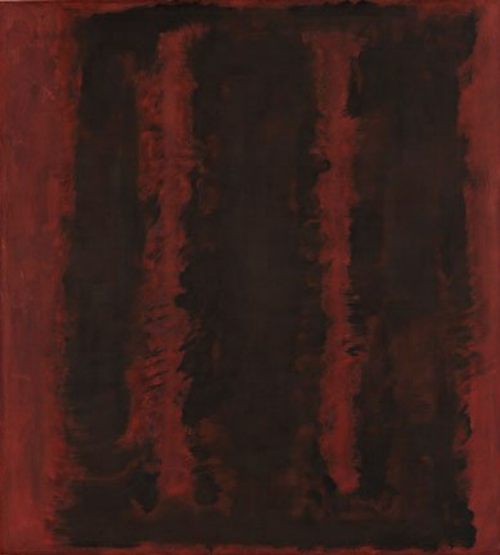‘The Child Must Banish the Father’: Mark Rothko and Intergenerational Strife
Mark Rothko, Black on Maroon, 1958
‘Movement is everything. Movement is life. The second we’re born we squall, we writhe, we squirm. To live is to move.’
There’s a splendid production of the 2009 play ‘Red’ by John Logan running at the Wyndham Theatre in London (until 28 July).
It is 1958-59. Mark Rothko has been commissioned to paint a series of murals for the glamorous Four Seasons restaurant in New York’s Seagram Building. In his paint-splattered Bowery studio he creates his work surrounded by whisky bottles, canvases, turpentine and brushes; in low light; to the sounds of Schubert and Mozart.
Rothko strives to convey raw truth, real feeling and pure thought - in maroon, dark red and black. His luminous paintings pulse with introspection, intensity and intellectual energy. He approaches his craft with high seriousness.
‘People like me… My contemporaries, my colleagues…Those painters who came up with me. We all had one thing in common…We understood the importance of seriousness.’
Rothko explains to his young assistant that he and his fellow Abstract Expressionists achieved their dominance of the post-war art scene by sweeping aside the previous generation.
‘We destroyed Cubism, de Kooning and me and Pollock and Barnett Newman and all the others. We stomped it to death. Nobody can paint a cubist picture now…The child must banish the father. Respect him, but kill him.’
Rothko’s assistant, however, is a fan of the emergent Pop Art movement; of artists like Jasper Johns, Robert Rauschenberg, Roy Lichtenstein and Andy Warhol. He challenges Rothko’s worldview.
‘Not everything needs to be so goddamn important all the time. Not every painting needs to rip your guts out and expose your soul. Not everyone wants art that actually hurts. Sometimes you just want a fucking still life or soup can or comic book!’
Rothko is unimpressed.
‘You know the problem with those painters? It’s exactly what you said: they are painting for this moment, right now. And that’s all. It’s nothing but zeitgeist art. Completely temporal, completely disposable, like Kleenex.’
Rothko’s frustration with Pop Art extends to the culture that has created and celebrated it. He rages against the triviality of modern life.
‘‘Pretty.’ ’Beautiful.’ ’Nice.’ ’Fine.’ That’s our life now! Everything’s ‘fine’. We put on the funny nose and glasses and slip on the banana peel and the TV makes everything happy and everyone’s laughing all the time, it’s all so goddamn funny. It’s our constitutional right to be amused all the time, isn’t it? We’re a smirking nation living under the tyranny of ‘fine’. How are you? Fine. How was your day? Fine. How did you like the painting? Fine. Want some dinner? Fine…Well, let me tell you, everything is not fine!...How are you?...How was your day? How are you feeling? Conflicted. Nuanced. Troubled. Diseased. Doomed. I am not fine. We are not fine.’
The argument gets personal. Rothko’s assistant points out that the artist’s seriousness and self-importance don’t sit well with his latest commission.
‘The High Priest of Modern Art is painting a wall in the Temple of Consumption.’
For me these bitter exchanges resonate with the intergenerational strife that we often encounter today in work and broader society. Each age cohort seems eager to celebrate its own triumphs, but reluctant to recognize the virtues of the cohort beneath them.
My own generation, born in the ‘60s, rejoices in punk’s destruction of ‘70s lethargy and hippy self-indulgence. We lionize our mix-tapes, style tribes, GTIs and political engagement. We rejoice in our hedonistic teens and our industrious twenties.
Yet, we moan about Millennials and make sarcastic remarks about Snowflakes. We complain about young people’s technology addiction and attention deficit disorders; their narcissism, impatience and indifference; the artisanal gins and avocado on toast; no-platforming and eating on public transport.
The younger generation can quite rightly retort with ‘80s materialism, sexism and sartorial blunders; the environmental apathy and the plain good fortune of the property market. They can coin their own labels: Centrist Dads and Gammons and so forth.
This intergenerational squabbling gets us nowhere. It betrays an inability to see life through anything other than the prism of our own experience.
Surely each generation is equal but different. One generation dances with their feet; the other dances with their hands. One wears white socks at the gym; the other wears black. One watches TV together; the other watches phones together.
I have been in awe of modern youth’s ability to diminish the gap between thought and action; their entrepreneurial spirit and technical facility; their comfort with diversity and their capacity to keep life and work in balance. They’re just as political, but they care about different issues. They’re just as stylish, but in skinnier jeans.
OK. Their music is not as good…
In the field of commerce the businesses that thrive are those that truly trust and enable the younger generation; that integrate old and new skills; that recognise the imperative of change. Because if a company fails to embrace generational difference, then eventually 'the child will banish the father.’ And the mother too.
Towards the end of ‘Red’ Rothko has a change of heart. After a dispiriting trip to the Four Seasons restaurant, he backs out of the lucrative commission. And he dismisses his assistant with something approaching good grace.
‘Listen, kid, you don’t need to spend any more time with me. You need to find your contemporaries and make your own world, your own life…You need to get out there now, into the thick of it, shake your fist at them, talk their ear off… Make something new.’
No. 185




